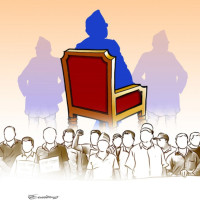Opinion
Hope for healing
Forgiveness and reconciliation are society-wide processes that will continue far beyond the TRC mandate
Prakash Mani Sharma
The approval of the transitional justice bill by the President’s Office is a milestone in Nepal’s peace process. Discussions surrounding the Truth and Reconciliation Commission (TRC) so far, however, signal a preoccupation with political, legal and logistical issues at the expense of a key aspect of reconciliation: healing.
Although the measures in the TRC suggest a restorative approach to justice with retributive elements, lessons from, for example, Latin America teach us that the workings of a TRC do not automatically lead to reconciliation. When old wounds are reopened in the absence of a supportive framework for healing, such a commission runs the risk of aggravating the very suffering, anger and polarisation it is supposed to be addressing. One of the slogans of South Africa’s TRC was “revealing is healing,” yet people’s anger and grief were compounded by the terrible truths that surfaced. Whether it actually achieved its goal remains a matter of dispute.
Towards healing
In Nepal too, the TRC process is bound to provoke painful emotions that should be adequately acknowledged and addressed. If not healed, they could block forgiveness
and reconciliation. Psychological studies show that when feelings of enemity towards one another do not change, violence is likely to recur. The principles and practices of restorative justice and psychology provide essential guidance on how this can be prevented. If genuine reconciliation is indeed the goal, it is imperative that the government, victims’ organisations, civil society organisations and institutions active in psychosocial counseling, mediation, dialogue facilitation and peacebuilding, as well as donors, consider these.
Restorative justice processes have taken place all around the world, including in Rwanda, Bougainville, Northern Ireland, Timor-Leste, Sierra Leone, Canada, Brazil, Japan and Norway. Considering the needs of the victims, offenders, and the community, they focus on healing relationships and restoring social harmony. Rather than being spectators to court processes, victims take an active role while perpetrators are encouraged to take responsibility for their actions and repair the harm done. Justice and truth are regarded as components of the process, not as ends in themselves. Restorative justice processes are usually mediated to ensure that they are rooted in empathy and bring about the fundamental changes in attitudes, perceptions and emotions necessary for reconciliation. As experiences in Brazil have shown, hearing the perpetrator express his own pain about the pain of the victim can have a powerful healing effect. One could argue that amnesty as an outcome of such a process will be just while amnesty granted in the absence of authentic reconciliation promotes impunity.
The following are just six of the many psychological and restorative justice principles and practices important to consider as Nepal embarks upon its own formal path towards reconciliation.
Facilitating reconciliation
First, when forgiveness and reconciliation are imposed, healing does not happen. Results will be shallow and unsustainable and therefore, counterproductive. Zimbabwe’s ‘Politics of Reconciliation’ is a case in point. These processes must be voluntary and thus, dependent on parties’ willingness to become involved. When the TRC guides them, respectful of the fact that their ownership lies with the individuals who go through them, as the government of Bougainville did, the outcomes will be more heart-felt and long lasting.
Second, psychological or physical insecurity felt by the victims and perpetrators will inhibit the TRC process and decrease the space for healing, forgiveness and reconciliation. In Rwanda and Sierra Leone, victims refrained from giving testimony due to fear of repercussions from perpetrators. Implementing a comprehensive witness protection programme, like the TRC did in South Africa, could help prevent this.
Third, restorative justice processes benefit from facilitation by trained and trusted mediators and dialogue facilitators. These professionals can assist the TRC in identifying who should be part of the process; prepare parties for the encounter; guide them through the process; constructively deal with emotions and enemy images; make certain that participation is voluntary; and ensure that all voices receive equal attention. As the ‘Victim-Combatant Dialogues’ in Northern Ireland illustrate, the availability of professional facilitation can boost willingness to participate.
Fourth, when victims and perpetrators receive psychosocial counseling, they will be more likely to reconcile. Studies from Rwanda suggest that victims who are left alone to deal with their feelings of anger, revenge and bitterness are far less willing to reconcile than those who receive psychosocial support. Healing of perpetrators increases the chance that they will acknowledge their responsibility for the violence, a crucial step towards reconciliation. When reconciliation is not possible (because the perpetrator or victim has died, or one of the parties is unwilling), services could focus on the individual processes of healing and forgiveness. For this purpose, the ‘Implementation of Psychosocial Counseling and Support Services to Conflict Affected Persons Project’, currently run by the Ministry of Peace and Reconstruction and the International Organisation for Migration, could be expanded.
Bottom-up approaches
Fifth, reconciliation extends beyond the victim-perpetrator relationship to include the web of relations in communities and society at large. The top-down process of the TRC should be complemented with bottom-up reconciliation. An example of the latter is the Dialogue Facilitation Program run by Pro Public in ten districts of Nepal. Teams composed of ex-People’s Liberation Army personnel and community members are currently healing relationships in their own villages. Community mediation, restorative circles, and forum theater are other ways of involving people.
Finally, recognising that healing, forgiveness and reconciliation are society-wide processes of deep change that will continue beyond the mandate of the TRC can help prepare for the future. Since reconciliation will underpin all of the constitution-writing, state-restructuring and land reform processes, mediation/dialogue facilitation services to promote and foster reconciliation should be an integral part of these.
In conclusion, the TRC has the challenging task of bridging the divide between Nep-al’s painful past and peaceful future. When the TRC embraces a restorative justice fra-mework and heeds the psychological aspects of reconciliation, it will actually be able to build a bridge called healing. This is where the potential of the TRC “to create an atmosphere of reconciliation in society” lies.
Sharma is executive director of Pro Public, an NGO, and senior advocate of the Supreme Court Bar Association




 9.12°C Kathmandu
9.12°C Kathmandu










